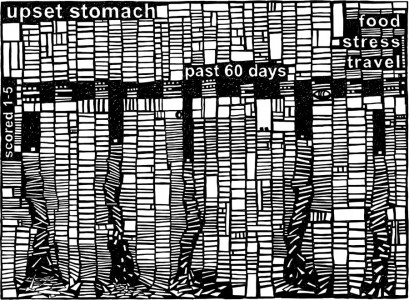Quantifying-me: what if the the walls produced ambient patterns of how I'm doing?
/ All the good stuff happens while you sleep. If you’re sick, you heal. You build procedural memory, grow taller, resolve conflict, reorder and organize long-term memory. I’ve been measuring my nightly sleep using an EEG headband for over a year, and there is a definite pattern to the brainwaves, with much more activity than you’d imagine. It’s ragged with shorter bursts of deep sleep and REM sleep than I thought. I wake up a lot. It’s weirdly comforting and reaffirming to receive a sleep score everyday. This morning I got a 73, for me it’s about a B+.
All the good stuff happens while you sleep. If you’re sick, you heal. You build procedural memory, grow taller, resolve conflict, reorder and organize long-term memory. I’ve been measuring my nightly sleep using an EEG headband for over a year, and there is a definite pattern to the brainwaves, with much more activity than you’d imagine. It’s ragged with shorter bursts of deep sleep and REM sleep than I thought. I wake up a lot. It’s weirdly comforting and reaffirming to receive a sleep score everyday. This morning I got a 73, for me it’s about a B+.
After building a body of work on sleep patterns and daily activity charts and showing it in Los Angeles. I’ve begun to think about a future where everything can be passively measured. What if walls could produce ambient patterns of how we’re doing, where we subtly adjust behavior in response to those measurements. So, feeling good about quantifying-me, a few months ago I significantly added to the daily regimen. And now measure my weight, how many steps I take, mileage, calories burned, heart rate variability, pulse, my color mood, daily micro-journal of an upset stomach, my tweets, movement of my computer mouse, all web browsing, everything on my laptop, phone data, webstats, my DNA from 23andMe….and realize it’s almost bottomless.
All these self-tracking systems have scores, numbers and infographics….but none seem to match how these activities feel or capture the sensibility of what’s measured. Believing in a connection between visual pattern and brain rhythm, I’ve set out to map a language to convey self-quantifying metrics. Numbers are abstract concepts, but our brains recognize pattern intuitively, I’m working on the vocabulary and grammar of pattern for self-tracking that’s more visceral and direct. It’s work in progress, and harder than it sounds.



